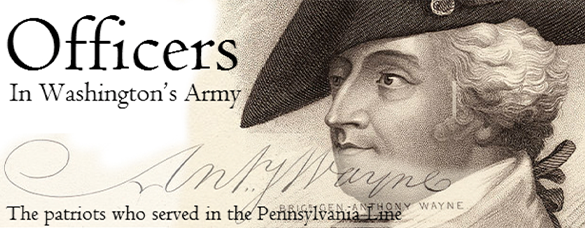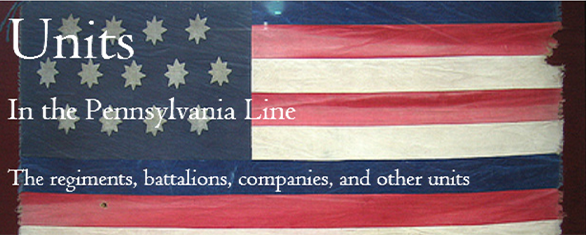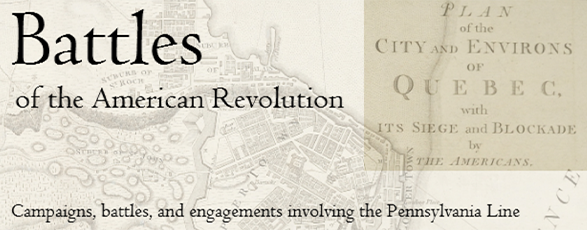Bear in mind that this data is focused on the Pennsylvania line, and it is not designed as a history of the battles, encampments, or campaigns in which it participated. There are many very good websites that carry that information. You will find a few in this section.
The information on this listing has been gleaned from five sources: Pennsylvania in the Revolution, Lines and Battalions, Pa Archives, 2nd series, Vols X and XI, edited by John B. Linn and William H. Egle, 1880; Pennsylvania Archives, Series 5, Vols 2 and 3, edited by Thomas Lynch Montgomery, 1906; Historical Register of Officers of the Continental Army, 1775-1783, by Francis B. Heitman, 1893; The Pennsylvania Line, Regimental Organization and Operations, 1776-1783, by John B. B. Trussell, Jr, 1977; and Virtutis Praemium, The Men who founded the State Society of the Cincinnati in Pennsylvania, Vols 1 and 2, by John D. Kilbourne, 1998. Where informational conflicts arose, usually concerning dates of rank, we chose what seemed best, based upon the data available. Such conflicts would sometimes arise due to the Continental Army’s habit of promoting an officer on a given date, termed the effective date, but stating that such a promotion would ‘rank from’ an earlier date. The ‘rank from’ date would determine seniority in the line. We have tried to be consistent in the dates, and have shown, as best we can, only the effective date.
We have worked on the presumption that if an officer is not shown to have resigned, or to have been sick, on furlough, killed, transferred, or deranged, then that officer was present for campaigns, battles, and encampments in which the unit participated. In cases where no date of joining a unit is specifically given, we have used the unit inception date. Deranged in the 18th century military was indicative of involuntary loss of position in a unit due to the merging of units, and too many officers for the assigned positions, which were then filled according to seniority.
In many cases, especially with the following units, information on officers is hard to find, as records are sketchy or nonexistent.
Von Heer’s Light Dragoons, authorized 27 May 1778, also known as the Provost Guard, or the Marechausse, had the job of apprehending deserters, rioters, and stragglers, plus securing fugitives in battle. They were attached to but not part of Washington’s Guard, and therefore probably accompanied him in New Jersey, New York, and Virginia. The last of the troop was discharged on or about 3 Oct 1783.
The 2nd Continental Artillery Regiment, also known as Lamb’s Artillery, originated in New York, and is mentioned in this listing only so long as two Pennsylvania Companies were part of it.
The 4th Continental Artillery Regiment, also known as Proctor’s Artillery, originated in Pennsylvania. Both of these artillery regiments, in accordance with the custom of the time, were scattered, by elements, throughout the Army during given actions. In the latter part of the war, elements of the 4th Regiment were at Fort Pitt, Carlisle, Lancaster, and with the Southern Army. It is therefore very difficult to track individual officers. Where they have been indicated by name in our sources, they are so shown; otherwise, there is no trace of them. The regiments were used in total in only a few actions, and have been indicated as such.
The 4th Continental Light Dragoons, also known as Moylan’s Cavalry, was authorized 1 Jan 1777, with the mission of scouting, patrolling, covering exposed flanks during actions, and courier service. Originally four troops of cavalry, later two troops of infantry were added. They were used in small, widely dispersed detachments, and therefore, like the artillery, tracking individual officers is very difficult. Where they have been indicated by name in our sources, they are so shown; otherwise, there is no trace of them. The Dragoons were used in total in only a few actions, and have been so indicated on the listing.
Pulaski’s, Ottendorf’s, and Armand’s Corps present the same tracking difficulties as the 4th Dragoons.
The Flying Camp, a mobile reserve, existed from July 1776 to about Nov 1776. It was composed of state troops, militia, and volunteers, the units being in service to Congress and being paid by Congress. The personnel assigned moved in and out as their terms of enlistment expired. There were also Continental soldiers assigned. The Flying Camp was known to be stationed in Amboy, NJ in July 1776, and at Fort Washington in Nov 1776.
The Invalid Corps, authorized 20 July 1777, was composed of men incapacitated by wounds or illness, and thus unable to serve in combat units. They had several functions in garrison: to serve as guards in cities and other places where ammunition magazines, arsenals, or hospitals are located; and to recruit soldiers for the army. The Corps was headquartered first in Philadelphia, Pa., and then after Jun 1781, in Newburg, NY. The last of the Corps was discharged at West Point, in 1784.
After the Mutiny of the Pennsylvania Line on 1 January 1781, all personnel belonging to numbered regiments were consolidated into the 1st, 2nd, 3rd, 4th, 5th, and 6th Pennsylvania Regiments. From these, officers and soldiers were assigned to three Provisional Units, and sent to the Southern Campaign. These three, in turn, were consolidated into two others by Gen Wayne as the personnel requirements of the Southern Army decreased in response to less military activity. For ease of tracking, we have kept those officers who were assigned to the Southern Campaign in the Pennsylvania Regiment to which they were assigned, as this was the unit that provided pay and promotion, and from which they eventually mustered out.
May you have as much enjoyment in perusing this material as we have in putting it together.



